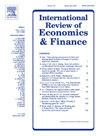Digital financial inclusion and urban-rural disparities
IF 5.6
2区 经济学
Q1 BUSINESS, FINANCE
引用次数: 0
Abstract
This study explores whether digital financial inclusion acts as an equalizer or a divider in reducing China's urban–rural economic disparities. Using provincial panel data from 2011 to 2022, we employ multiple empirical methods to investigate the relationship between digital financial inclusion and regional income gaps. Baseline regression results indicate a significant negative association between digital finance and the urban–rural income gap. Dimensional decomposition reveals that usage depth has a stronger convergence effect than coverage breadth, emphasizing that access must be matched by effective use of digital services. Mediation analysis identifies industrial structure upgrading as a key transmission mechanism, suggesting that digital finance promotes convergence by enhancing both immediate financial service accessibility and longer-term economic transformation. Threshold regression analysis indicates that the equalizing effects of digital financial technologies are somewhat more pronounced in regions with lower foreign investment penetration and innovation capacity, challenging assumptions about the necessity of high absorptive capacity for technological benefit. To further ensure the validity of our results, we address endogeneity concerns through instrumental variable regression, propensity score matching, and the Heckman two-stage model. The core findings remain robust across all approaches. Additionally, heterogeneity analysis reveals that the impact of digital finance on narrowing urban–rural disparities is particularly strong in western provinces and in regions north of the Hu Huanyong Line, where traditional financial barriers are most evident. Together, these findings highlight digital financial inclusion as a convergence-promoting force, particularly in less developed areas, and provide practical guidance for policy interventions aimed at reducing regional income gaps and promoting inclusive growth.
数字普惠金融与城乡差距
本研究探讨了数字普惠金融在缩小中国城乡经济差距方面起到的是均衡器还是分压器的作用。本文利用2011 - 2022年的省级面板数据,采用多种实证方法研究了数字普惠金融与地区收入差距的关系。基线回归结果表明,数字金融与城乡收入差距呈显著负相关。维度分解表明,使用深度比覆盖广度具有更强的收敛效应,强调接入必须与数字服务的有效使用相匹配。中介分析发现,产业结构升级是关键的传导机制,表明数字金融通过提高即时金融服务可及性和长期经济转型来促进趋同。阈值回归分析表明,数字金融技术的均衡效应在外国投资渗透率和创新能力较低的地区更为明显,挑战了关于技术效益必须具有高吸收能力的假设。为了进一步确保结果的有效性,我们通过工具变量回归、倾向得分匹配和Heckman两阶段模型来解决内生性问题。核心发现在所有方法中都是可靠的。此外,异质性分析显示,数字金融对缩小城乡差距的影响在西部省份和胡焕庸线以北地区尤为明显,传统金融壁垒最为明显。总之,这些发现突出了数字普惠金融作为促进趋同的力量,特别是在欠发达地区,并为旨在缩小区域收入差距和促进包容性增长的政策干预提供了实用指导。
本文章由计算机程序翻译,如有差异,请以英文原文为准。
求助全文
约1分钟内获得全文
求助全文
来源期刊
CiteScore
7.30
自引率
2.20%
发文量
253
期刊介绍:
The International Review of Economics & Finance (IREF) is a scholarly journal devoted to the publication of high quality theoretical and empirical articles in all areas of international economics, macroeconomics and financial economics. Contributions that facilitate the communications between the real and the financial sectors of the economy are of particular interest.

 求助内容:
求助内容: 应助结果提醒方式:
应助结果提醒方式:


